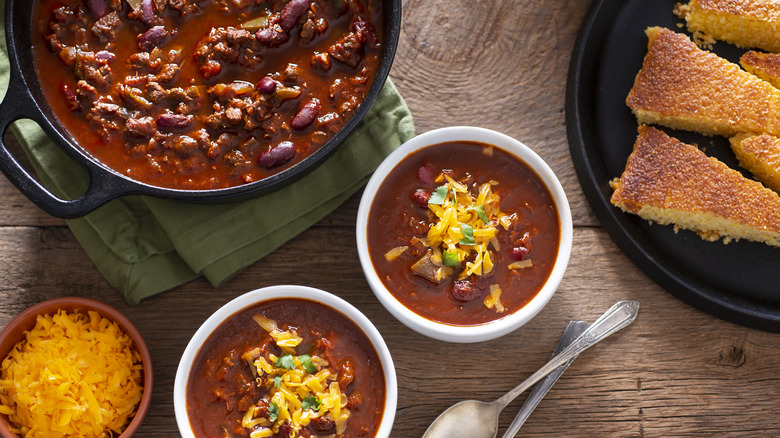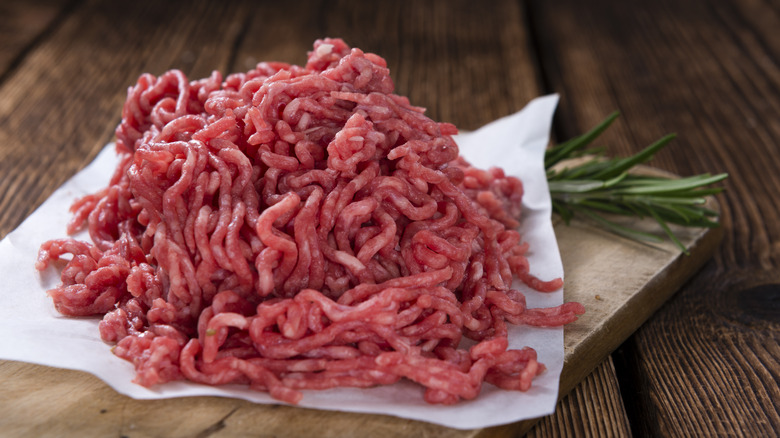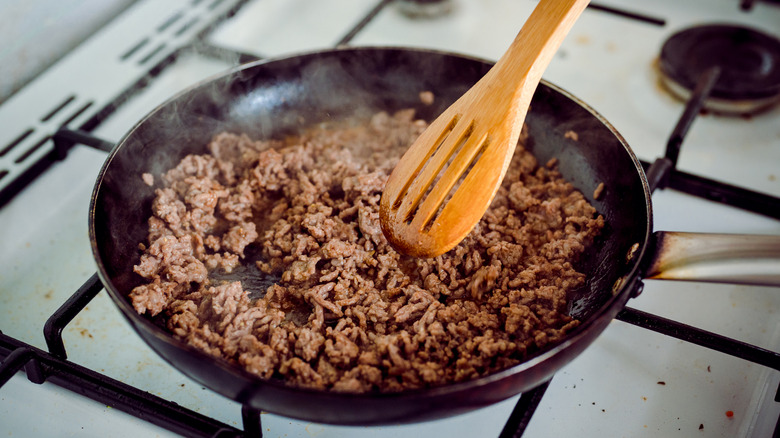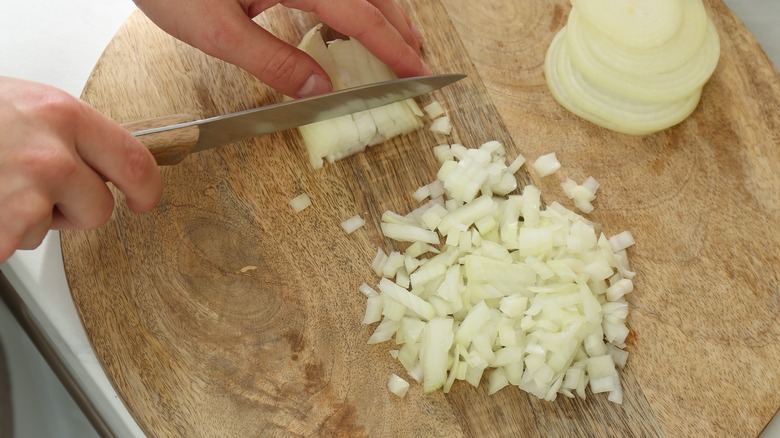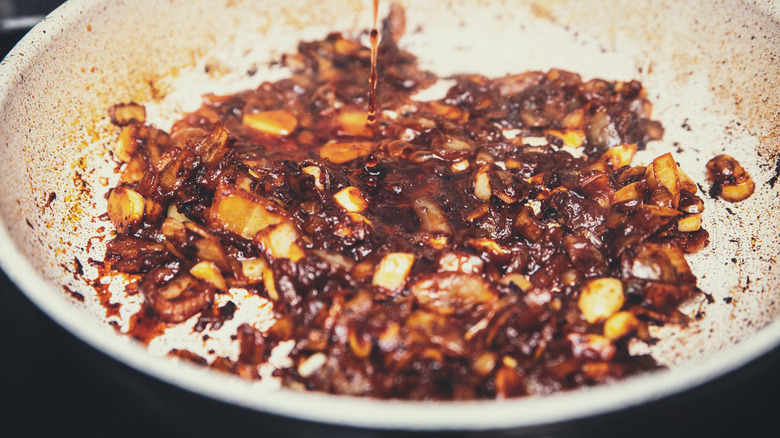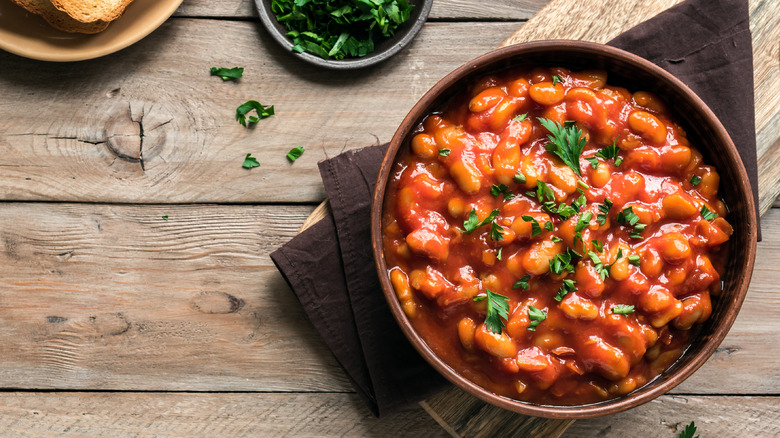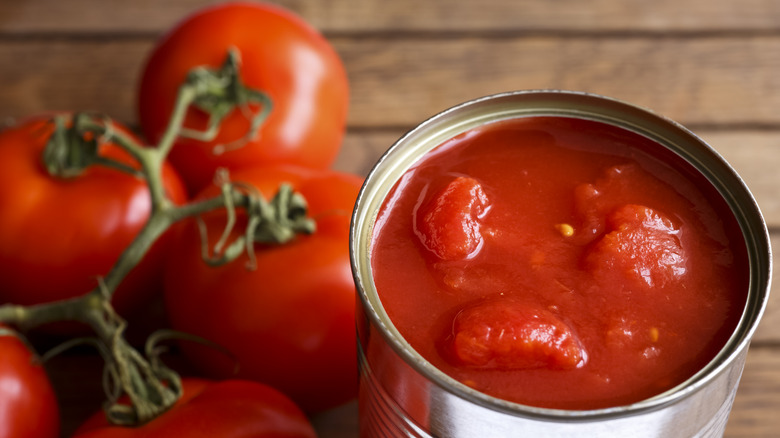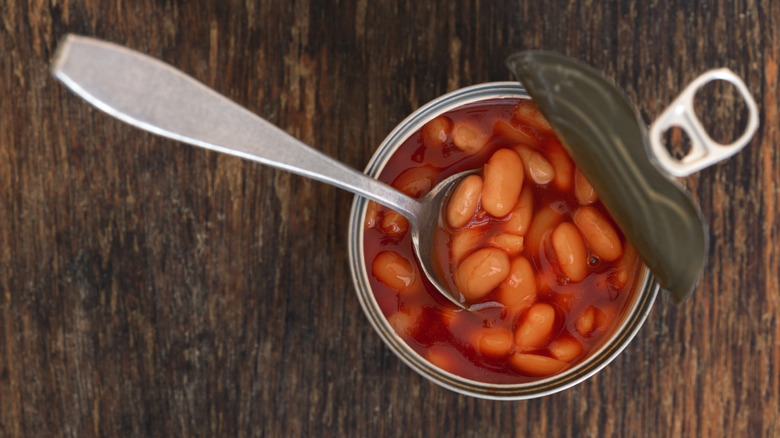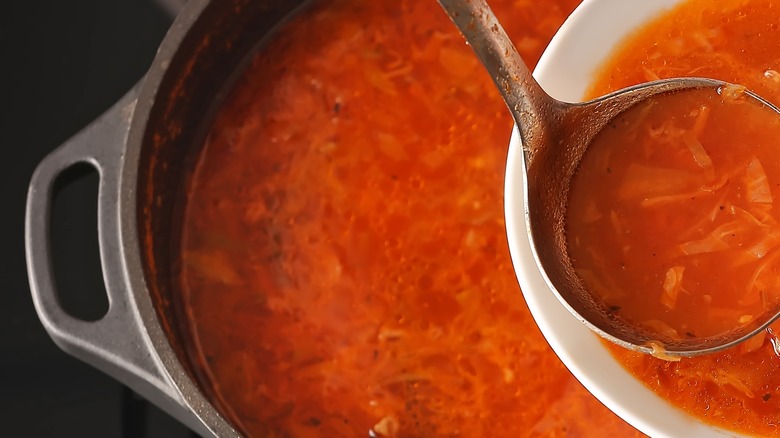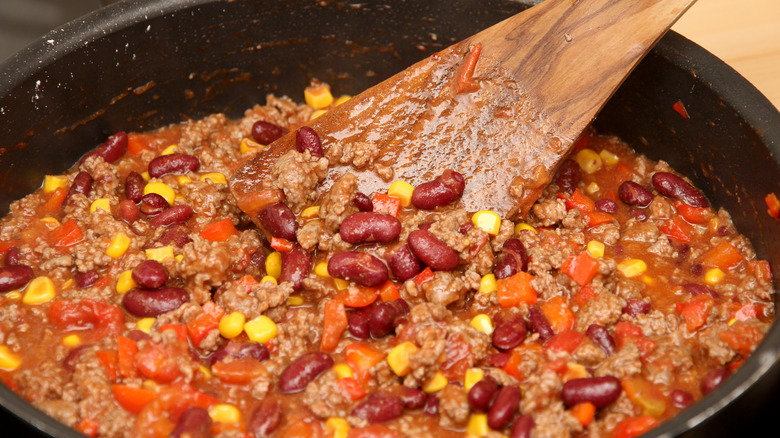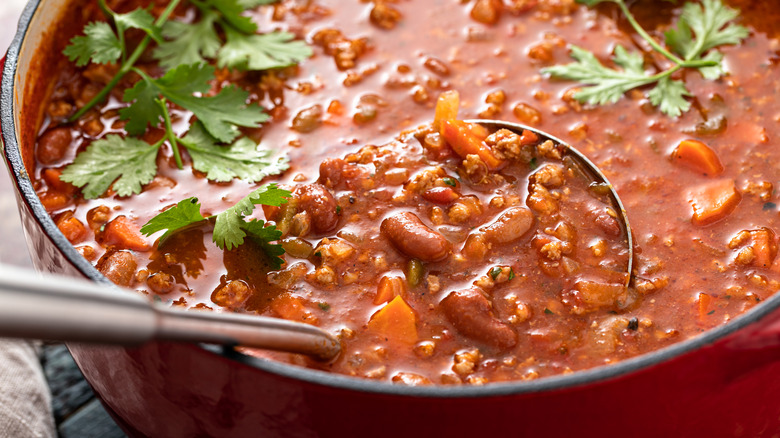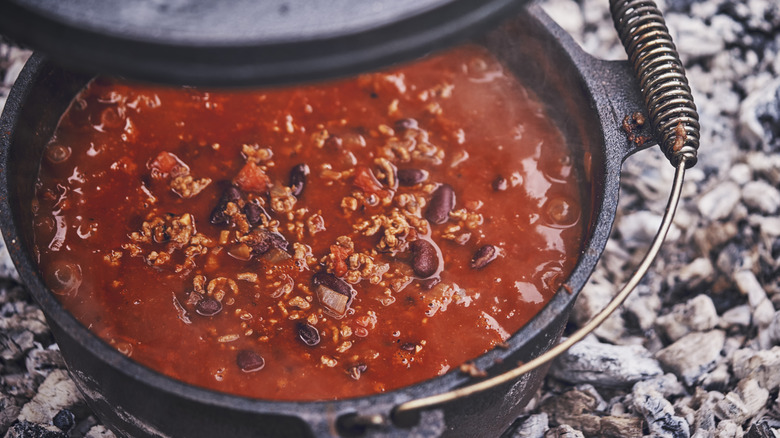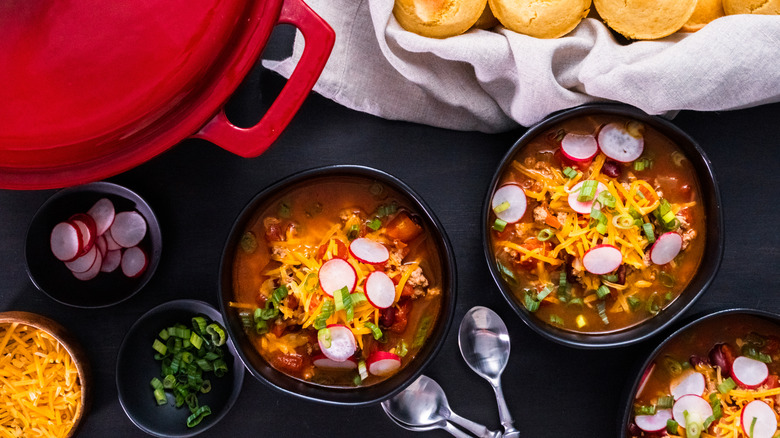The Chili-Cooking Mistakes We All Make
Whether you're looking for something hearty to fight off the winter chills, prepping a game day feast for you and some friends, or just looking for the ultimate in comfort foods, chili always delivers. Although it may be relatively simple to make soup, chili packs serious flavor. With savory, smoky, sweet, and spicy notes, chili is as complex as it is satisfying— a literal one-pot wonder of versatility, sensory experience, and down-home, cozy tradition.
While the typical recipe for chili couldn't be more straightforward — sauté ground meat with onions and garlic, add beans, tomatoes, and spices, and let it all simmer — the process of making chili also has some complexities you might not expect. Thousands of books have been written, contests won, and careers made by cooks who have mastered this unique art. What do those experts know about chili making that the rest of us could learn from? Read on as we detail the most common chili-cooking mistakes everybody makes from time to time, plus how to avoid them.
1. Using the wrong meat
Every great pot of chili starts with high-quality ingredients. That doesn't mean you have to use the expensive, gourmet stuff to make your dish; It just means you need to use good foods. Start the process right by selecting the ideal meat. While an 80/20 blend of ground beef may be a bit cheaper, it's going to add a lot of extra grease to your chili. It can also be tough, and if you drain that fat away, you're losing valuable flavor. Instead of buying that entry-level packet of meat, opt for a slightly higher quality package of ground beef with at least an 85/15 ratio of lean to fat. You could even go up to 90/10 — that way, your chili still benefits from getting some added fat, but your pot won't have tons of grease bubbling around its surface.
Alternately, you might also consider a blend of different ground meats, like a combo of beef plus pork, for example. This is another fantastic way to add layers of flavor and complexity to your chili instantly. You can also combine a mixture of ground beef plus ground chicken or turkey for a naturally lighter, leaner chili that's still packed with robust flavor. Or, ask your butcher to grind your beef for you if you have a few extra minutes. That way, you can select from potentially more flavorful options than chuck or round, including shoulder cuts of beef as well as sirloin.
2. Not properly browning your beef
Ever been served a bowl of chili that just seemed off — clumpy, flavorless, chewy, or with a tough, almost chalky texture? Many of those problems start very early in the cooking process when a cook is browning their meat. Your browning technique can impact the quality of your chili way more than you might realize.
To brown meat properly, first, make sure you always start with a hot pan. When you add meat to a cold skillet that's heating up, it's more likely to cook unevenly and can wind up tough and rubbery. Also, be wary of putting too much ground meat in a pan to cook all at once, especially if you're making a large batch of chili. Cook in batches instead, if necessary. When you overcrowd a skillet, the meat steams instead of browning, which can again impact its flavor and texture.
Also, always brown meat in a large skillet with a heavy bottom (like a cast-iron skillet) — this helps to ensure maximum searing. Season your meat well as it cooks to start building layers of flavor. Preventing clumping and burning by using your spoon or spatula to break the ground meat into smaller pieces as it cooks. But don't stir too frequently. Allow the meat to brown nicely on one side before flipping or stirring. This promotes more even cooking and also helps the meat to develop a flavorful crust, which your chili will thank you for later on.
3. Adding raw onions or garlic to your chili
They may be bitter and pungent, but onions are also magical. They make almost everything taste better. But be careful. As any magician — or good chef — will tell you, even magical items need to be used with care.
When making chili, it can be tempting to brown your meat, throw in your beans and tomatoes, add a handful of chopped onions and garlic, and then let everything simmer. But that's a huge mistake. Raw onions tend to overpower other foods, even spicy foods like chili. They're slow to cook and can also give your chili a weird, crunchy texture plus a sharp, biting aftertaste. And if you have a sensitive stomach, watch out — they're sure to leave you reaching for the Alka Seltzer.
Instead of adding onions or garlic to your chili late in the cooking process, these aromatics should actually be one of the first things you cook when your meal is just getting started. Sauté onions and garlic in oil or butter on their own. Cook them in an otherwise empty skillet until they're soft and tender. This will also help to mellow their flavor. Let them cook long enough to caramelize, and they'll also develop a wonderful added sweet, nuttiness that can be a fantastic addition to your chili's overall flavor profile. So, never just toss them in at the end. Start your chili prep around these potent flavor powerhouses, and build the rest of your dish around them!
4. Forgetting to deglaze your skillet after cooking meat
Once your ground meat is perfectly browned, don't just toss that dirty skillet into the sink and move on with your chili-making extravaganza. That's another common mistake many of us make, and it's a waste of great added flavor that could make your chili even richer and more robust. Instead, you need to deglaze your pan and salvage all those wonderful drippings.
For those who don't know, deglazing a pan is a relatively simple technique where a liquid like broth, wine, vinegar, or even water is added to a pan to turn those leftover brown bits from searing meat or veggies (called fond) into a sauce. To deglaze like a pro, add ¼ to ½ cup liquid to a hot pan as soon as your meat is done searing (and has been removed to rest). Then, use a spatula or wooden spoon to scrape the bottom of your pan and loosen and dislodge all those wonderful leftover brown bits of food — and flavor. Stir the water and "fond" mixture well. Then, lower the temperature of your burner and let the liquid concentrate and thicken. The more it reduces, the more flavorful the liquid mixture will become.
If you were cooking steak or chicken, you might add butter or milk to this deglazed mixture to make a proper sauce. But for chili, you don't need that extra step. Just pour your deglazed liquid straight into your stockpot and continue along with your chili prep.
5. Assuming chili has to have meat
Maybe you like to start the week "clean" with a Meatless Monday. Maybe someone you're cooking for adheres to a plant-based diet. Or maybe you just really love beans. Whatever the case, it's a mistake to think that mouth-watering chili must always include meat. Vegetarian chili is naturally lower fat, lower calorie, and packed with more vitamins, minerals, and fiber. But there are other reasons to indulge in it from time to time besides better nutrition.
Vegetarian chili can be an incredible showcase for different blends of herbs and spices that don't always work well with meat. You can highlight warming flavors like cinnamon or deep, rich smoked paprika. Add ground coriander to your bean-based chili and marvel at its refreshing citrus-like qualities. Thai basil, fennel, allspice, and sumac can also be incredible additions to vegetarian chilis, creating flavors that just wouldn't hit in the same way if there was meat present in the dish.
You can also pack plant-based chilis full of fresh herbs and veggies that might seem out of place in a savory beef-based chili. Choose your favorite mixture of beans and tomatoes and then finish your dish with unexpected additions like fresh basil or mint, diced bell pepper, fresh corn, diced zucchini, or even cubed sweet potatoes. You could also add finely chopped kale or spinach to a plant-based chili, or throw in some cremini or shiitake mushrooms for a meaty texture and umami flavor — you won't even miss that beef.
6. Picking the wrong canned tomatoes
Along with beans and ground meat, sweet, tangy tomatoes are part of the trifecta of flavors that make chili so beloved and delectable. In summer, when fresh tomatoes are cheap and abundant, chopping up a bunch of ripe, firm fruit and making a beautiful seasonal sauce is easy. But the rest of the year, we generally need to turn to canned tomatoes for our chili-making needs. And this is where your selection of which tomatoes you add to your chili can really make a big difference.
Low-quality and generic brands of canned tomatoes tend to pack less flavor. They can also be overly salted or have that weird metallic taste common in budget canned foods. In terms of the type of canned tomato you buy, tomato puree and crushed tomatoes are better for pasta sauces. They have no real structure and turn to liquid as they cook, making your chili soupier. Petite-diced tomatoes aren't much better. Instead, start your chili with diced tomatoes or whole tomatoes that you roughly dice yourself. Both will hold their shape better as they cook and give your chili more of that chunky texture you're likely after.
Fire-roasted tomatoes are also an incredible option for chili. They have a fantastic charred, smokey, sweet flavor that works wonderfully with common chili spices like paprika or cumin. Also, consider imported Italian San Marzano canned tomatoes, which some cooks swear by due to their savory, rich flavor and low acidity.
7. Adding beans to chili right from the can
All canned beans are not created equal. And depending on the beans you buy — or that you have stashed in your pantry — you need to prep them differently before you add them to your chili. Take a standard can of black beans or kidney beans, for example. Never open one of these bad boys and dump it directly into anything you're making, chili or otherwise. The liquid inside that can is safe to eat — but it can be filled with sodium, preservatives, tinny metal flavors, and complex sugars that the body can have trouble processing (creating gas). Not good. Instead, always dump canned beans in a colander and drain and rinse them before use. This not only cuts down on their saltiness and improves their flavor, but will also help your chili to taste better overall.
Of course, every rule — especially in cooking — has its exceptions. Some beans come pre-sauced in a spiced, flavorful liquid that's a bit like a broth or soup. If your beans say they are in a "chili sauce" or make any other claims about already being flavored and ready to use in some way, then, by all means, dump them right into your chili pot. (Or, better yet, take a little taste of the sauce to make sure you like the flavor and then add them. Better safe than sorry!)
8. Too much liquid
Part of the charm and culinary appeal of chili is its thick, chunky consistency. It's heartier and more satisfying than an "ordinary" soup. It's a proper meal, but one that's still served in a bowl and eaten with a spoon. In other words, it's got to be thick. If your chili tends to be on the thin or watery side, that's a mistake it's time to fix!
Excess water doesn't just make chili bland and weak-tasting. It also makes the spices and flavors in your chili less robust and powerful overall. And watery chili is harder to eat — nothing clumps together on your spoon correctly, so you don't get that ideal mixture of spices, flavors, and textures that make chili so special and unique.
To avoid overly watery chili or chili that's just too thick (which can also be a common problem), aim for a ratio of either 1:1 or 1:2 when it comes to meat and beans. So, 1 pound of beef and 1 16-oz. can of beans, or 2 cans of beans if you prefer. To this mixture, add approximately 1 cup of liquid (broth, tomato sauce, or crushed tomatoes). Then, judge the consistency of your chili. If you want it thinner, go ahead and add another cup of liquid. But with this as your starting point, your chili should never wind up too watery.
9. Boiling instead of simmering
Once you have all your chili ingredients in your stockpot, heating on the stove, the hard part is done. But mistakes can still happen. This time, the error many people make is with the temperature they set their stove to.
Flavor builds through gentle cooking. Yes, when you first put your chili on the stove, you want to bring all those soupy ingredients to a boil. But once you notice bubbles in your chili and you know that it's boiling, don't leave it cooking at this high temperature. All foods are more likely to burn when exposed to high heat. Beans can overcook and turn to mush. Meat can turn tough and rubbery. The high heat that makes chili boil is just too aggressive to food over an extended period.
Instead of letting your chili boil continuously, lower the temp once it starts to bubble and let it simmer gently instead. (You can even whip out a food thermometer to test your temperatures. Boiling occurs at 212 degrees Fahrenheit; simmering is typically considered to occur at anywhere from 195 to 211.) This will help to prevent your chili ingredients from breaking down too quickly, preserving their texture and integrity. Simmering also allows flavors to build over time. The longer your chili cooks at a lower temperature, the more your spices and other ingredients will be able to release their flavors and contribute to that extraordinary chili flavor.
10. Imbalanced flavors
As your chili simmers, you have one last challenge to face: making sure your dish is well-balanced and that all your flavors work together well. Taste the chili regularly as it cooks, and consider each essential flavor profile you want it to capture. Start with acidity. Does your chili have a bright tang and bite? Is the flavor vibrant, and does it have a subtle, pleasing tartness on the tongue? If the answer is no, add a touch of acid in the form of wine, vinegar, or lemon or lime juice. Too tart? Mellow those acid flavors a tad with some brown sugar or honey.
Next, consider the level of spice in the chili. It shouldn't be so overwhelmingly hot that you can't eat it. Instead, look for layers of flavor and heat — perhaps an initial bit of fire but also a pleasant, lingering heat and overall warmth. If it's too bland, add a teaspoon (or more to taste) of classic chili seasonings like chili powder, cumin, paprika, onion or garlic powder, or even black or cayenne pepper. On the flip side, if your chili is too spicy, mix-ins like corn, sweet potatoes, or caramelized onions can help to neutralize and balance that excessive heat.
Finally, is your chili savory? Does it taste rich and meaty — does it have the right umami punch? If not, consider sautéing some mushrooms and tossing them in. Or, add a splash of soy sauce, fish sauce, or even cooked, crumbled bacon. Mmmmm.
11. Not letting chili rest before serving
From steaks to roast chicken to pasta dishes and even bread and cakes, foods of all types taste better when they've been allowed a few minutes of "rest" before they're served. Chili is no different. Resting food, or allowing it to cool slightly before you start to eat it, serves a number of different purposes. When food cools and is no longer under extreme heat, flavors combine better, and textures even out. Tastes become more vibrant and robust, and juices settle. Food just becomes more delicious and enjoyable.
To let your chili rest before serving, remove it from the hot burner, put the lid on your pot, and leave the dish undisturbed for at least 5 to 10 minutes. When that time is up, remove the lid and look inside. If you see oil or grease that has accumulated on the surface of the chili, now is the time to skim it off. This will help your chili taste smoother and less greasy. When that's done, give the chili a couple of final good stirs, and then grab your ladle and bowls.
12. Too many toppings
Finally, and perhaps most importantly, remember that a bowl of chili doesn't have to look like a plate of nachos in order to taste great. Sure, you can add many of the same toppings — tortilla chips, sour cream, cheese, fresh diced peppers or tomatoes, olives, and more — but you don't have to use them all. When we make the mistake of adding too many toppings to our chili, we lose a lot of what makes the dish so special: that smoky, earthy burn of the chili powder itself, the umami richness of the meat, the tang of the tomatoes, and the firm, nutty almost sweet taste you get from beautifully cooked beans.
To avoid loading up on too many varied and diverse toppings, pick a theme or flavor profile for inspiration, like "garden freshness" or "Southwest," and then stick to only foods with those flavor profiles. Try to select no more than three to four different types of toppings in total — perhaps one that's creamy or that contains dairy (like your favorite grated cheese or tangy Greek yogurt), something fresh (like diced avocado or green onions), something salty (crumbled crackers or corn chips, for example), or something that packs some heat (hot sauce or jalapeno peppers are both great options). That way, you're adding a variety of different flavors to your chili, but you aren't using foods that compete or that cancel each other out. This is the key to keeping your chili tasting balanced and still enjoying all of its inherent natural goodness. Now, dig in!

